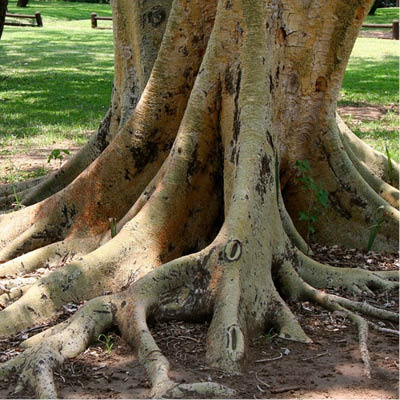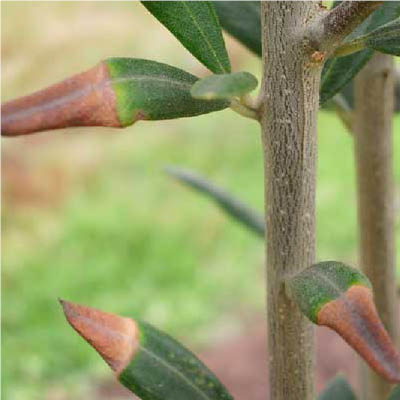
Arbor-Wellness: Long Term Effects of Drought on Trees and Shrubs
Recurring periods of drought seem to have become commonplace in the Western US in recent years. The effects on trees and shrubs can often be seen in both natural and man-made landscapes during the severest of droughts as leaves wilt, show marginal scorch, or prematurely drop from the plant. However, the long-term effects of drought on the health and survivability of woody plants are less obvious.
Furthermore, the perception of drought can be misleading. In California, we experienced six years of low overall total rainfall, but especially low winter rains, when plants adapted to our climate are used to and need. And while some years since then have appeared more normal, some years that rainfall occurred in just a few storms. Studies in other parts of the country have shown that native trees need at least six well placed, significant storms throughout the rainy season to allow for proper soil moisture and tree response.
With respect to influence on plant growth and health, it is the amount and frequency of rainfall received during the growing season that is of greater significance than the total amount of precipitation in a given year. When defining a drought year, the pattern and frequency of rainfall are clearly more important than the total amount of rain.
Water relations in plants
To understand the impact of drought on plants, a review of water relations can be helpful. Without water, there is no plant life. Most of the chemical and metabolic processes in the plant use water as a part of the process, including photosynthesis.
The uptake and transport of mineral nutrients occurs in water. Minerals dissolved in soil water move into plant roots and then to their transport system within the tree itself.
Water itself is moved through a plant by transpiration or the evaporation of water from plant leaves. Tiny pores in leaves control the amount of transpiration. They open and close in response to water availability as well as other internal and external factors. Interruption of this process occurs because of a of lack of water in the soil, which stops or reduces the flow of water, leading to wilting of leaves.

Drought effects on plants
Drought conditions, or more specifically, soil water deficits, can influence the normal physiology and growth of plants in many ways. One common problem that develops is the accumulation of salt near the roots. When there is not enough water in the winter to flush salts from the soil, they accumulate near the roots. The result is dried leaves from “salt” damage. This is one of the primary causes of the redwood decline that is so common now.
Another problem when a water deficit occurs is that soil water tends to shrink away from the interface with water-absorbing roots, creating a gap in the soil-plant-air continuum. As the plant continues to lose water via transpiration, water is drawn from root cells resulting in shrinkage of cells and eventually death of the cells in the root. This of course compromises the ability of the tree to recover when water is available again. It can also lead to instability in the soil from the decline of roots.
In the root system of a tree or shrub, the delicate root hairs that extend from epidermal cells and feeder roots at the extremities of the root system are responsible for the bulk of water uptake. Confined to the upper 15 inches or so of the soil profile, they are also the first part of the root system affected by dry soil conditions. With the death of root hairs, the water absorbing capacity of the plant is severely reduced.
The effect of drought is particularly bad for newly transplanted trees and shrubs since they are already lack a sizeable portion of their water-absorbing roots – the roots being lost in the transplanting process.
The lack of water reduces most of the metabolic processes in the tree, but in particular the processes that create defensive enzymes, tannins and alkaloids. As the severity of drought persists, the amount of secondary metabolites decreases and plants become vulnerable to secondary attacks by certain insects and diseases.
With prolonged drought, the ability to produce normal growth tissue is slowed down. Before a plant can resume normal growth rates and rebuild damaged tissue (stems and roots), it must devote energy to developing the photosynthesis process itself. This consumes food reserves to start the process of food (carbohydrate) production. Therefore, visible symptoms of drought-related decline in plant health may not be evident for weeks, months, or years after the drought event. Further decline will often take place while repairs to root system, stems and internal processes are made, again taking months or years depending upon the severity and duration of soil water deficits.
Symptoms
The effects of drought can be characterized as short term and long term. Immediate visible effects of drought damage include wilting, scorch, and some defoliation due to loss of turgor in plant cells, irreversible shrinkage of cell membranes, and increased synthesis of abscisic acid. Long-term symptoms of drought include dieback of branches and death of the plant as the plant’s capacity to absorb water is damaged. These are the primary or direct effects of drought.

Secondary effects
There are also secondary effects that relate to the reduction in synthesis of secondary metabolites. Susceptibility to disease infections and insect invasion is heightened as the plant’s ability to ward off these problems is diminished.
It is difficult to attribute plant disease problems to drought a year or two after a drought event, especially if the current year is a moist one. However, there are certain diseases that are more likely to occur because of drought related stress on the plant. These diseases in combination with weather history at the site can be used in the diagnosis of drought related problems. Among the types of diseases likely to occur in response to drought related stress are root rots, cankers, wood rots, and wilt.
A good example of delayed secondary effects of drought on trees and shrubs is Armillaria root rot, also called shoestring root rot because the fungus forms shoestring-like structures called rhizomorphs that invade roots. Armillaria is an opportunistic fungus, that is, it is generally present in soil and on the surface of roots but only invades when roots are weakened or damaged by some type of stress, such as drought. In a healthy plant, the disease can be isolated or compartmentalized. A drought stressed tree with reduced metabolic activity may not be able to compartmentalize the disease. The fungus invades cambium tissue and is capable of killing a small tree in a season or two. Large trees with an extensive root system may not begin to show symptoms of decline until half the root system is killed by the fungus. This may occur several years after the drought event and initial invasion by the Armillaria fungus.
Among the canker type diseases likely to be encountered are Nectria canker and Cytospora canker. These diseases are almost always associated with drought stress. Again, it is the inability of the plant to synthesize protective chemicals and to compartmentalize wounds that allows for infection and development of the diseases. Drought stressed trees and shrubs are also predisposed to several other diseases including Diplodia tip blight, Rhizosphaera needlecast and Verticillium wilt.
Insect problems
The invasion of wood boring insects such as bronze birch borer, black stem borer (Ambrosia beetle), and other bark beetles, noticeably increases in trees that are drought stressed.
Studies have shown a correlation between the levels of the secondary metabolite, oleoresin, and a plant’s susceptibility to invasion by wood boring insects. A healthy tree produces oleoresin that acts to deter feeding by borers. When a tree is severely stressed, there is a decrease in oleoresin production and a corresponding increase in borer attacks.
Conclusion
While drought periods may come and go, plant practitioners need to be aware that the negative effects of drought on plant growth and health may continue to be a problem for years to come. It is important to keep this in mind when evaluating the causes of plant problems. Sign up for an inspection today!